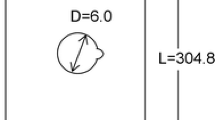Abstract
Fatigue and corrosion fatigue damage of materials is often the most important cause of frequent stops of machines and industrial equipment. For this, many researches are investigated in this field. The aim of this work is to study the effect of the corrosion pit density on the fatigue life of aluminum 1050A. Fatigue and corrosion fatigue tests carried out under tension-compression loading with load ratio R = − 1, at frequency of 78 Hz, and ambient temperature on not corroded and corroded specimens in 3.5% NaCl solution during different immersion times. From the experimental study, it was concluded that the pitting density increases as the immersion time increases and does not have a large effect on the fatigue strength of aluminum 1050A after 8-, 24-, 40-, 56-, and 72-h immersion.
Similar content being viewed by others
References
Sanni O, Loto CA, Popoola API (2016) Inhibitive behaviour of zinc gluconate on aluminium alloy in 3.5% Nacl solution. Silicon 8(2):195–200. https://doi.org/10.1007/s12633-014-9180-8
Amarnath L, Bhattacharjee A, Dutta K (2016) Ratcheting fatigue behaviour of Al-7075 T6 alloy: influence of stress parameters. Mater Des 115:012018. https://doi.org/10.1088/1757-899X/115/1/012018
Sadeler R, Totik Y, Gavgalı M, Kaymaz I (2004) Improvements of fatigue behaviour in 2014 Al alloy by solution heat treating and age-hardening. Mater Des 25:439–445. https://doi.org/10.1016/j.matdes.2003.12.003
Smith WF (2001) Materials science and engineering, Translated Author: Kınıkoğlu, N.G. (Turkish), Literature Publications, Istanbul, Turkey
Rooy EL (2005) ASM international handbook, properties and selection: nonferrous alloys and special-purpose materials. In Introduction to aluminum and aluminum alloys, vol. 2, The Materials Information Company, USA
Sakin R (2016) Fatigue-life estimation and material selection for commercial-purity aluminum sheets. Res Eng Struct Mat 2(2):89–104. https://doi.org/10.17515/resm2015.30me1205
Sakin R, Muharrem ER (2010) Investigation of plane-bending fatigue behavior of 1100-H14 aluminum alloy. J Fac Eng Archit Gazi Univ 25(2):213–223
Zhang W, Lv S, Li Z, Yao L, Tong X (2015) Relationship between fracture characterisation and fatigue life of pre-corroded aluminium alloy. Mater Res Innov 19(sup 5):S5-239–S5-244. https://doi.org/10.1179/1432891714Z.0000000001085
Ishihara S, Nan ZY, Mcevily AJ, Goshima T, Sunada S (2008) On the initiation and growth behavior of corrosion pits during corrosion fatigue process of industrial pure aluminum. Int J Fatigue 30:1659–1668. https://doi.org/10.1016/j.ijfatigue.2007.11.004
Ilman MN (2014) Chromate inhibition of environmentally assisted fatigue crack propagation of aluminium alloy AA 2024-T3 in 3.5% NaCl solution. Int J Fatigue 62:228–235. https://doi.org/10.1016/j.ijfatigue.2013.03.008
Withy B, Campbell S, Stephen G (2014) The influence of corrosion pits and cold expanded fastener holes on the fatigue life aluminium 7075-T651. Adv Mater Res 892:87–92. https://doi.org/10.4028/www.scientific.net/AMR.891-892.87
Pereira MC, Silva JWJ, Acciari HA, Codaro EN, Hein LRO (2012) Morphology characterization and kinetics evaluation of pitting corrosion of commercially pure aluminium by digital image analysis. Mater Sci Appl 3:287–293
Guérin M (2015) Corrosion-fatigue lifetime of aluminium-copper-lithium alloy 2050 in chloride solution. Mater Des 87:681–692. https://doi.org/10.1016/j.matdes.2015.08.003
Abdulstaar MA, Mhaede M (2014) Fatigue behaviour of commercially pure aluminium processed by rotary swaging. J Mater Sci 49:1138–1143. https://doi.org/10.1007/s10853-013-7792-9
Soliman MS, El-danaf EA, Almajid AA (2012) Enhancement of static and fatigue strength of 1050 Al processed by equal-channel angular pressing using two routes. Mater Sci Eng A 532:120–129. https://doi.org/10.1016/j.msea.2011.10.072
Sakin R (2016) Investigation of bending fatigue-life of aluminum sheets based on rolling direction. Alexandria Engineering Journal 57:35–47. https://doi.org/10.1016/j.aej.2016.11.005
Reddy AC (2015) Fatigue life prediction of different joint designs for friction welding of 1050 mild steel and 1050 aluminum. International Journal of Scientific and Engineering Research 6(4):408–412
Höppel HW, Mathias G, Kümmel F, Haus T (2016) Enhanced fatigue lives in AA1050A / AA5005 laminated metal composites produced by accumulative roll bonding. Acta Mater 120:150–158. https://doi.org/10.1016/j.actamat.2016.08.039
Naeimi M, Eivani AR, Jafarian HR, Boutorabi SMA, Shams H (2017) Correlation between microstructure, tensile properties and fatigue life of AA1050 aluminum alloy processed by pure shear extrusion. Mater Sci Eng A 679:292–298. https://doi.org/10.1016/j.msea.2016.09.113
Eivani AR, Hosseini M, Jafarian HR, Anijdan SHM, Park N (2017) Microstructural evolution and fatigue properties of severely deformed AA1050 aluminum alloy. Mater Charact 130:204–210. https://doi.org/10.1016/j.matchar.2017.06.016
Höppel HW, May L, Prell M, Göken M (2011) Influence of grain size and precipitation state on the fatigue lives and deformation mechanisms of CP aluminium and AA6082 in the VHCF-regime. Int J Fatigue 33:10–18. https://doi.org/10.1016/j.ijfatigue.2010.04.013
Kümmel F, Tegtmeier T, Höppel HW (2017) Optimized layer architecture for an extended fatigue life of ultrafine-grained AA1050 / AA5005 laminated metal composites. Mater Sci Eng 194:012036. https://doi.org/10.1088/1757-899X/194/1/012036
Makabe C, Socie DF, andSueyoshi T (2004) Shear mode fatigue crack growth in 1050 aluminium. Fatigue Fract Eng Mater Struct 27:669–678. https://doi.org/10.1111/j.1460-2695.2004.00788.x
Acknowledgments
The authors would like to thank the Physical Metallurgy and Property of Materials laboratory of Badji Mokhtar University Annaba for specimen preparation. Thanks are due to the Metallurgy and Materials Engineering Department of Badji Mokhtar University for fatigue tests. A great thank to the Institute for Ship Structural Design and Analysis, Hamburg University of Technology (TUHH), Germany for the scientific issue.
Author information
Authors and Affiliations
Corresponding author
Rights and permissions
About this article
Cite this article
Adjel, S., Merakeb, N., Benchouia, S. et al. Effect of corrosion pit density on the fatigue life of aluminum 1050A. Int J Adv Manuf Technol 97, 3163–3177 (2018). https://doi.org/10.1007/s00170-018-2163-y
Received:
Accepted:
Published:
Issue Date:
DOI: https://doi.org/10.1007/s00170-018-2163-y




